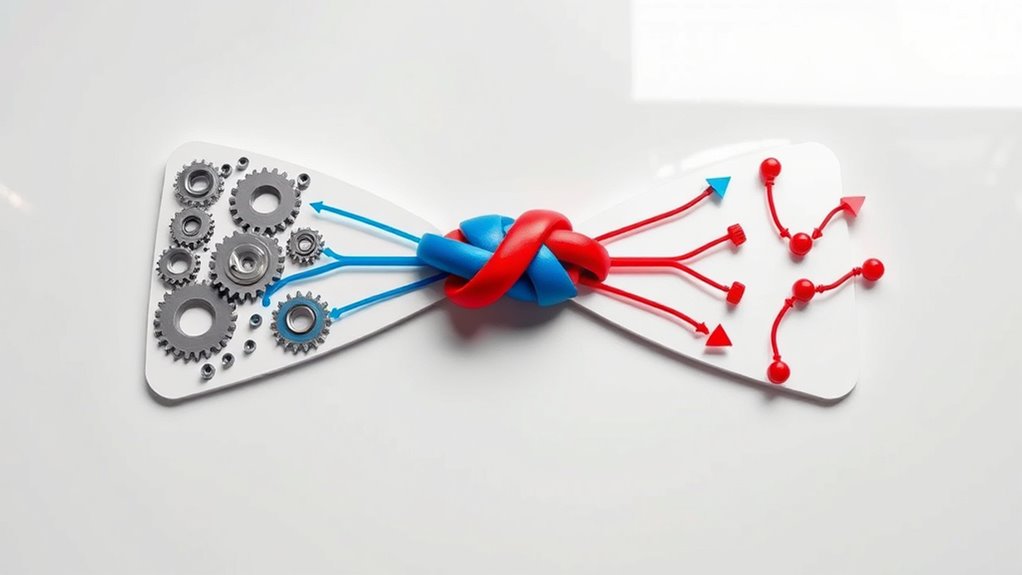The Bow‑Tie Model helps you clearly connect causes that lead to hazards with their potential consequences, offering a visual framework to understand risk pathways. It highlights vulnerabilities, shows how safety barriers might fail, and emphasizes the importance of controls. This approach helps prioritize safety measures and develop effective risk strategies. If you want to explore how this model enhances your risk management and bridges causes and impacts, there’s more to discover ahead.
Key Takeaways
- The Bow‑Tie Model visualizes how causes lead to hazards, which then result in consequences, effectively bridging cause-and-effect relationships.
- It integrates hazard analysis with cause-and-effect thinking to clarify pathways from risks to impacts.
- By illustrating barriers and controls, it highlights points where causes can be prevented or consequences mitigated.
- The model promotes understanding of complex risk interactions, enabling targeted prevention and response strategies.
- It provides a structured framework that connects underlying causes to potential outcomes, enhancing comprehensive risk management.

Have you ever wondered how organizations can visualize and manage complex risks effectively? The answer often lies in the power of risk management tools like the bow-tie model. This model provides a clear, visual way to understand how hazards can lead to specific incidents and what controls are in place to prevent or mitigate those incidents. It’s a practical approach that bridges the gap between identifying causes and understanding their potential consequences, making it easier to develop extensive risk strategies.
At its core, the bow-tie model combines hazard analysis with cause-and-effect thinking. You start by identifying a hazard—something with the potential to cause harm—in a given process or environment. From there, you examine the possible causes that could lead to that hazard materializing. This step is vital because it helps you uncover vulnerabilities and weaknesses in your current risk management approach. It prompts you to ask essential questions: What could go wrong? What are the triggers? By thoroughly analyzing these causes, you can implement preventive controls designed to stop the hazard from developing into an incident.
On the flip side, the bow-tie model also emphasizes understanding the consequences if the hazard does turn into an incident. You look at what could happen if controls fail or are bypassed, which helps in preparing effective mitigation measures. These are the barriers or safety mechanisms that can reduce the severity of outcomes or prevent escalation. The visual nature of the model makes it easy to see the relationship between causes, the central hazard, and the potential impacts. This clarity helps you prioritize risk mitigation efforts, allocate resources wisely, and ensure that safety measures are aligned with real threats.
Using the bow-tie model enhances your hazard analysis by providing a structured, visual framework that combines proactive and reactive risk management. It encourages you to think holistically about risks—not just about what might go wrong, but also about how to prevent and control those risks if they do. Incorporating comprehensive risk assessment into your strategy ensures a more resilient safety culture. It’s particularly effective in complex environments where multiple factors can contribute to an incident, allowing you to see the full picture at a glance. By integrating this model into your risk management process, you create a culture of safety that’s rooted in clear understanding and strategic planning. Ultimately, the bow-tie model equips you with a practical, visual tool to manage risks more effectively, reducing the likelihood of accidents and their potential impacts.
Frequently Asked Questions
How Can the Bow-Tie Model Improve Risk Management Strategies?
You can enhance your risk management strategies by using the bow-tie model to improve risk visualization. It clearly maps out hazards, causes, and potential consequences, helping you understand where vulnerabilities lie. This approach enables you to implement proactive mitigation measures before issues escalate, reducing the likelihood of incidents. By visually connecting causes to effects, you gain an all-encompassing view that supports better decision-making and more effective risk controls.
What Industries Most Benefit From Applying the Bow-Tie Model?
In manufacturing and energy sectors, you’ll find industries flourishing with the focus on risk reduction and resilience. Applying the bow-tie model helps you visualize vulnerabilities and controls, seamlessly connecting causes to consequences. It’s especially beneficial for maintaining manufacturing excellence and ensuring energy safety. By bridging hazards with safeguards, you’re empowered to proactively prevent incidents, improve safety standards, and optimize operations, making these industries safer, smarter, and more sustainable.
Are There Limitations to the Bow-Tie Model’S Effectiveness?
You might wonder if the bow-tie model has limitations. It can sometimes lead to over simplification, ignoring complex interactions in processes. Additionally, data limitations can hinder its effectiveness, as incomplete or inaccurate information affects risk analysis. While useful for visualizing causes and consequences, you should be cautious, recognizing that it doesn’t capture all nuances. Use it as a tool, but don’t rely on it solely for all-encompassing risk management.
How Does the Bow-Tie Model Integrate With Existing Safety Frameworks?
Imagine uncovering hidden links in your safety strategy—that’s what the bow-tie model offers. It seamlessly integrates with existing safety frameworks, enhancing risk assessment by clarifying cause-and-effect relationships. By visualizing threats, barriers, and outcomes, it strengthens safety integration, helping you pinpoint vulnerabilities. This dynamic approach complements your current methods, making safety management more all-encompassing, proactive, and ready to tackle unforeseen challenges before they escalate.
Can the Bow-Tie Model Be Adapted for Dynamic or Complex Systems?
You can adapt the bow-tie model to dynamic or complex systems by integrating adaptive modeling techniques. This allows you to update risk scenarios and controls as system complexity evolves, ensuring real-time responsiveness. By incorporating flexible structures, you can better manage uncertainties and interdependencies, making the model more effective in complex environments. This approach helps you maintain safety and resilience despite ongoing changes and unpredictable system behaviors.
Conclusion
By embracing the Bow-Tie Model, you bridge the gap between causes and consequences, building a balanced, boundless blueprint for risk management. This simple, strategic structure supports your safety stance, secures your systems, and sustains your success. Stay savvy, stay safe, and systematically structure your strategies with this seamless model. Remember, understanding, uncovering, and uniting causes and consequences creates clarity, confidence, and control—making your risk management robust, reliable, and ready for any challenge ahead.









